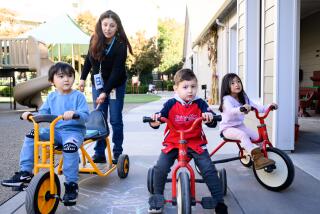Some Kids Strike Back by Striking Out
- Share via
Jewish religion instructors begin teaching right and wrong to children once they turn 3. Catholics start holding them accountable at age 6 or 7.
But mental health experts say that knowing the right thing to do is a separate matter from doing the right thing. Children with even the most severe conduct disorders--torturing animals or setting fires--know their actions are wrong as surely as did the 6-year-old from Richmond who is being blamed for the near-fatal beating of 4-week-old Ignacio Bermudez Jr. as he lay in his crib.
“I’ve seen it thousands of times and the story’s always the same,” said Dr. Hans Steiner, professor of psychiatry at Stanford University’s School of Medicine. “What you typically find is that most aggression in kids is reactive, driven by some upset.”
Only about one in 10 juvenile murderers is in the category of stone-cold predator, Steiner said. The rest, he said, have, in their few short years, accumulated a series of hurts--typically from an economically stressed single parent whose parenting doesn’t mesh with the child’s difficult temperament. They develop attachment problems that result in rejection by teachers and friends. Then, “under the influence of being extremely upset, they do all kinds of impulsive and inconsiderate things,” he said.
There has been massive research on treating conduct disorders in children, said Steiner, who has written national guidelines for the American Academy of Child and Adolescent Psychiatry. “They’re multi-deficient, usually [in] learning, impulse control and affect regulation. You have to provide treatment over months, not days,” he said. Treatment also involves parent training and rebuilding trust and empathy, which can take years.
The experts agree that they are seeing more cases of disturbed, aggressive children. But some argue that the increase is only more apparent because the numbers of juveniles are growing and does not necessarily mean that society is producing a new breed of exceptionally cruel children. In any case, as the numbers of juveniles are expected to increase 12% by the turn of the century, mental health professionals expect to see more cases like that of the Richmond boy until, Steiner said, “we decide that it’s something we want to take care of.”
A Bay Area psychologist recalled a case similar to the Richmond case in which a resentful 5-year-old had repeatedly attacked a younger sibling from infancy. Both children had been abused, neglected and eventually orphaned. By age 5, the younger child was setting fires, hurting animals and acting out sexually, said Chinita Trotter.
The younger child, sent to child protective services, received years of therapy and now, at 12, has shown signs of developing a conscience, empathy for others and a desire to be “normal,” she said. The older child has just been released from the juvenile justice system with limited therapy. “No one saw him as a victim,” she said.
Dr. Elissa Benedek, a psychiatrist and director of the Center for Forensic Psychiatry, based in Ann Arbor, Mich., worries about what will happen to the children who are punished rather than treated. “What’s going to happen to a youngster in one of those kiddie jails where they’re picked on, abused and learn to identify with more and more aggressors?”
* Lynn Smith’s column appears on Sundays. Readers may write to her at the Los Angeles Times, Life & Style, Times Mirror Square, Los Angeles, CA 90053. Please include a telephone number.
More to Read
Sign up for Essential California
The most important California stories and recommendations in your inbox every morning.
You may occasionally receive promotional content from the Los Angeles Times.








